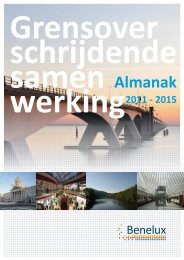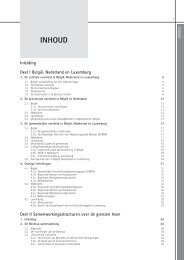The North Seas Countries' Offshore Grid Initiative - Initial ... - Benelux
The North Seas Countries' Offshore Grid Initiative - Initial ... - Benelux
The North Seas Countries' Offshore Grid Initiative - Initial ... - Benelux
You also want an ePaper? Increase the reach of your titles
YUMPU automatically turns print PDFs into web optimized ePapers that Google loves.
6 Conclusions and Outlook<br />
6.1 Discussion on Results<br />
NSOCGI has proved to be an important platform for collaboration between the European<br />
Commission, Governments, NRAs and TSOs. It has considered two different regional<br />
design approaches concerning the offshore part of the infrastructure necessary to meet<br />
the 10 Governments’ energy mix ambitions, including the accommodation of expected<br />
volumes of offshore wind energy to achieve targets in 2020 and beyond<br />
<strong>The</strong> <strong>North</strong> <strong>Seas</strong>’ Countries are committed to addressing climate change and reducing<br />
emissions in the longer term [8]. Although there are EU-wide renewable targets to 2020,<br />
there are none beyond this point. <strong>The</strong>re is therefore considerable uncertainty over the<br />
generation mix, including the predicted level of renewable generation in the <strong>North</strong> <strong>Seas</strong>,<br />
for the period 2020 to 2030, because each country might follow individual 2030 targets<br />
or has an individual approach to deliver the EU’s 2050 decarbonisation objective with<br />
individual assumptions concerning the neighbours’ decisions [8].<br />
In summer 2011 the Governments provided their individual generation and load forecasts<br />
for 2030. <strong>The</strong> TSOs applied their knowledge and expertise to develop plausible grid<br />
designs to accommodate the expected generation mixes at optimal grid investment cost.<br />
6.1.1 <strong>Initial</strong> findings<br />
Based on the NSCOGI 2011 forecasts of generation and demand in 2030, the analysis<br />
carried out in this study showed that the meshed solution is slightly better (by<br />
77 M€ p.a.) than the radial one, in terms of variable electricity production costs,<br />
investment cost into grid assets and related variable operation and maintenance costs.<br />
However, the significance of this difference in the context of a 30 bn€ investment in the<br />
grid has to be tested with further analysis using other scenarios and executing some risk<br />
assessment.<br />
<strong>The</strong> volume of new offshore RES between 2020 (the base year) and the studied year (2030)<br />
in the Reference scenario was relatively small, with only 13 GW predicted for new<br />
connections across the region. This is in contrast to the expected developments for other<br />
fuel types e.g. gas capacity increasing by 63GW during the same period. <strong>The</strong> findings of<br />
this study should therefore be considered against this background.<br />
6.1.2 <strong>The</strong> scenario is fundamental to results<br />
<strong>The</strong> development of the Reference scenario was the result of a joint exercise by<br />
Governments and TSOs in the summer of 2011. <strong>The</strong> Reference scenario was built up from<br />
Governments’ best views taking into account national policies at that time and planning<br />
considerations. Governments are well placed to make such forecasts given their role in<br />
supporting specific technologies and making planning decisions.<br />
Page 59 of 142










